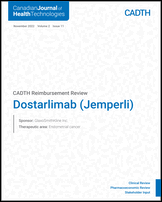| Baseline characteristics of patient population. | Appropriate. The clinical experts consulted by CADTH agreed that the baseline patient characteristics of cohort A1 of the GARNET trial was reflective of patients in Canadian clinical practice for the present indication. The trial population was slightly younger and healthier (all ECOG ≤ 1), but the clinical experts consulted by CADTH noted that patients with ECOG 2 would be treated the same way in practice. Furthermore, no differential treatment effects would be expected from the different disease-management practices across countries. |
| A lifetime time horizon of 40 years. | Appropriate. This time horizon is adequate to capture all lifetime associated costs and outcomes for the indicated population. |
| The distribution of chemotherapies comprising the CMT basket was based on the distribution of therapies in the UK RWE cohort represented by NCRAS data.1 | Inappropriate. The UK RWE patient cohort did not reflect the indicated population. |
| The distribution of hormone therapies comprising the CMT was derived from a health care claims study that examined treatment patterns and clinical outcomes in advanced and recurrent EC patients in Alberta, Canada.1 | Uncertain. |
| For patients receiving dostarlimab, the estimated distribution of post-progression therapies was based on second-line treatments received by patients in the UK RWE cohort. For all other comparators, the distribution of post-progression therapies was based on third-line treatments received by patients in the UK RWE cohort. Additionally, 46% of patients receiving dostarlimab were assumed to have received a subsequent therapy after the discontinuation of dostarlimab. For comparator therapies, it was assumed that 30% of patients would receive subsequent treatment.1 | Inappropriate. Given that the comparator patient population did not reflect the indicated population (i.e., not appropriately matched for dMMR or MSI-H status), the proportion of patients who received subsequent therapies after discontinuation of dostarlimab, based on RWE data, is not generalizable to the indicated population. The generalizability of these estimates, as well as the estimated distributions of therapies received after progression, were also not validated by CADTH. However, the estimated proportion of patients expected to receive subsequent therapies after progression has a minimal impact on model results. |
| The probabilities of grade 3 or higher AEs were derived from the GARNET study for dostarlimab, whereas probabilities for all other comparators were assumed to be equal to AEs seen with doxorubicin in the ZoptEC phase III randomized controlled trial.11 Grade 3 or higher treatment-related AEs included in the model reflected those with an incidence ≥ 5%.1 | Likely acceptable. |
| General population mortality data obtained from Statistics Canada lifetables for 2017 to 201914 were used to cap OS estimates according to age-specific survival rates, such that the sponsor assumed that OS in the patient population would not exceed that of the general population at each age.1 | Appropriate. The clinical experts consulted by CADTH indicated that the prognosis for the indicated population is poor and that OS would rapidly decline after progression, suggesting that OS would not exceed that of the general population. |
| Despite which treatment was received (dostarlimab or alternative therapy), all patients were assumed to be screened for dMMR or MSI-H status. As such, there are $0 incremental costs associated with IHC screening among patients who received dostarlimab. The cost for screening dMMR and MSI-H per patient was assumed to be $133.1 | Inappropriate. The clinical experts consulted by CADTH indicated that screening for dMMR or MSI-H status is not performed in all Canadian jurisdictions; it remains unknown what proportion of patients is unscreened. Even if all patients were assumed to be unscreened, the impact of IHC screening costs likely has a negligible impact on model results. |
